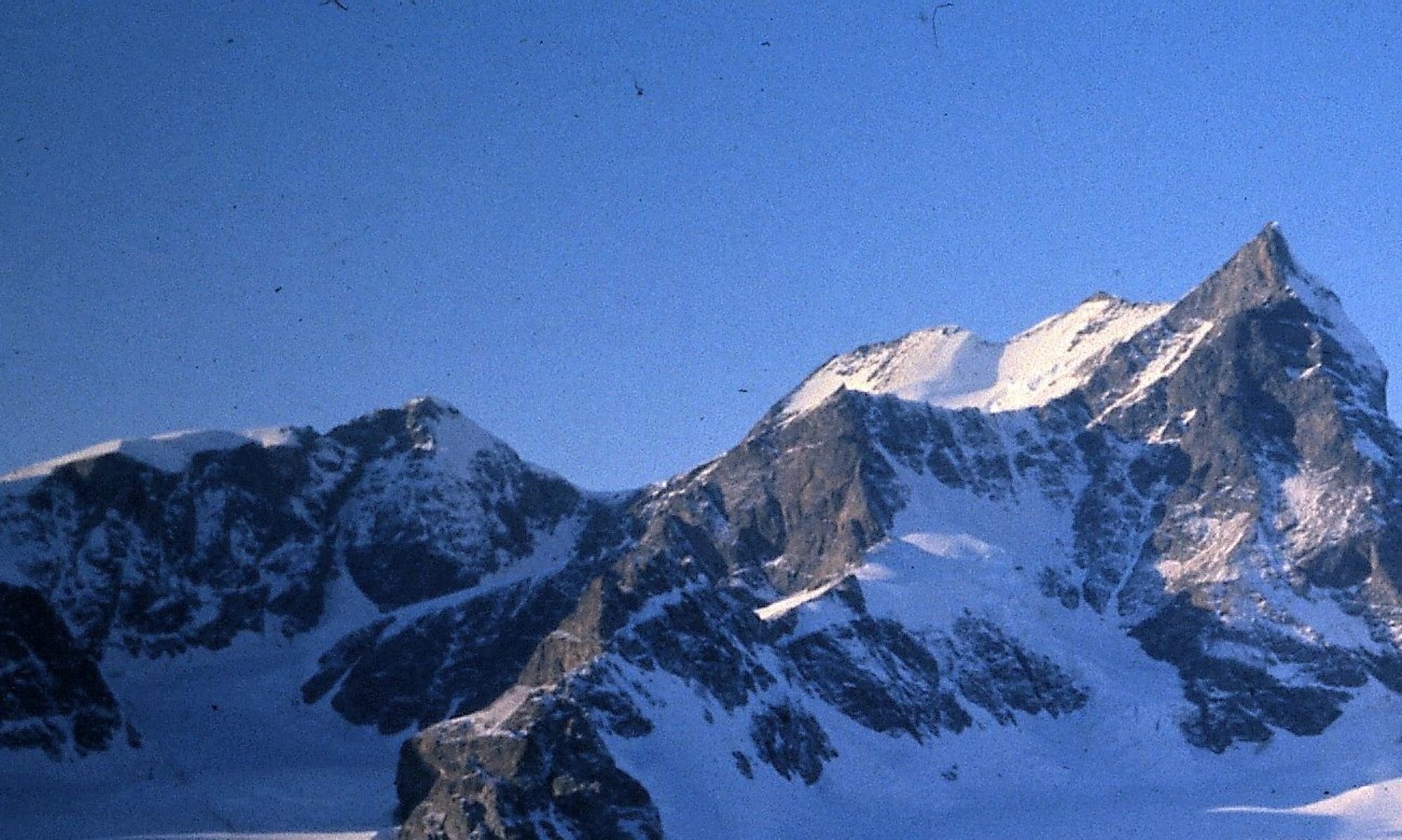All photos by Mike Warr unless otherwise stated

“We congregated at Hampton House. Meteorologists gravitated forty feet down the rock face to Hampton. John, at Rymill Hut, once the radio schedules were done, headed back up the “High Street”. George worked in the generator and tractor sheds, but always had reasons to go to Hampton House. Most of Jim’s stores were close by. Doc Tom’s physiological testing took him wherever his victims were. Tom Miller as the cook was at Hampton House. It was our security blanket in an isolated and frozen land.”
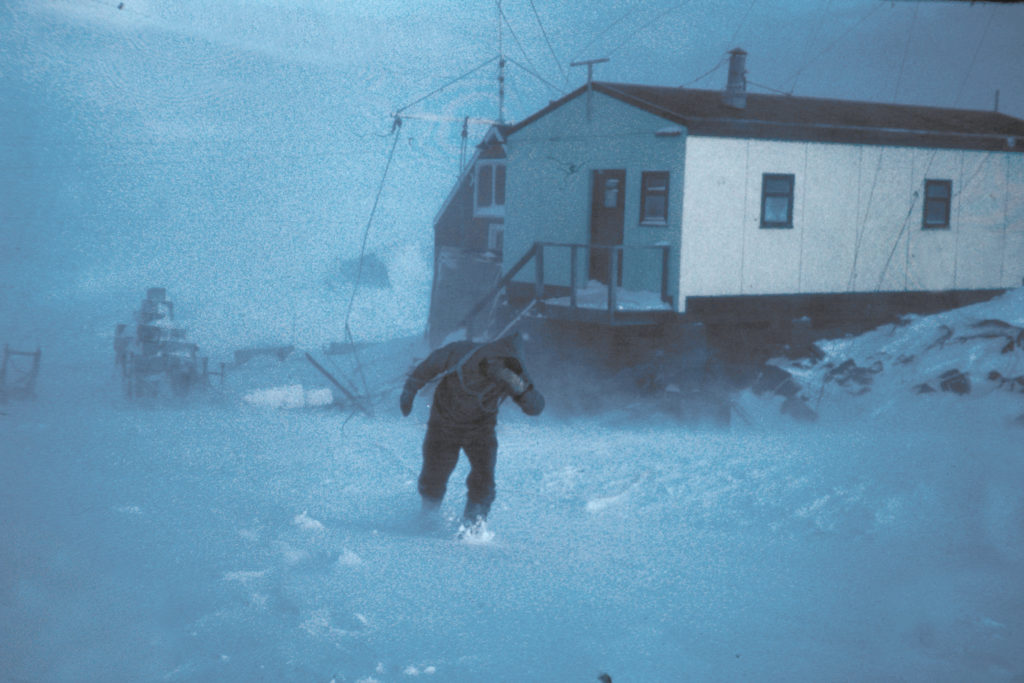
“The stony “High Street” led up to the porched entrance of Hampton House. Inside, on the immediate right, was a cold wooden seat over a five-gallon toilet receptacle. On the left was the bathroom whose hot water tank was heated by the adjoining kitchen stove. Next to the kitchen was the small photographic dark room. To the right were the gramophone and a bookcase full of paperback books, some easy, some classics.
The living room took up the most space. Light coloured walls contrasted with a dark red linoleum floor covered with two red patterned rugs. To the left, hemmed in by a few easy chairs was the coal-fired heating stove with a bent chimney going up through the ceiling. The two small windows that flanked the stove were draped with dark curtains though there were no neighbours to look in.

Opposite was a large dining table with its attendant tubular steel chairs. In March we had melted old 78 records, and turned them into flowerpots for our daffodils, that took pride of place in the middle of the table. Behind the table a shelf, filled with paperbacks, ran along the wall. On the end wall hung a clock that observed our goings on; below the clock a door led to our sleeping quarters.
Inside the base bedroom, eighteen wooden bunks were attached to the walls. With only nine bodies there was plenty of choice. I had a middle bunk. I piled books in the back of my three-foot high space. My sleeping bag lay on a mattress, with pyjamas and a pillow scattered at one end. Climbing slings, karabiners, and leather mitts hung down from above. Some people draped curtains across this, their only private space.”

“For gash duty, the toilets’ contents and the kitchen refuse were pushed down the “High Street” on a sledge to the tidal crack where the sea ice rose and fell. The icy jaws refused nothing though occasionally a pup might be seen strolling back from the jetty with what looked like a frozen sausage in its mouth. Not everything from our toilet made it to the sea. The gulls also benefited from our deposits.”
“I bathed less often than at Deception Island.

At Adelaide, water only flowed off the glacier between mid-February and mid-March. For most of my baths during the year I would push a clean sledge up to a packed snowdrift and cut large snow blocks with a saw. The blocks were taken to Hampton House, and tipped into the hot water tank. Several hours later after the water heated up I could bathe. As we now had a washing machine my clothes did not have to share my bath”.
“Scatology was of more importance than the above topics. We would facetiously repeat the unfortunate Titus Oates statement on Scott’s fatal return journey from the South Pole by saying: “I am just going outside and may be sometime,” as we headed to the toilet. Our steady eating meant frequent flatulence, and so were the comments like: “Speak up Brown, you’re coming through.”
“Our major warm base diversion for July was building a bar. It was not a necessity, but it gave the base a group project. Roger was the driving force behind this undertaking. Food boxes in the old hut next to Hampton were moved out. The bar was in one corner complete with a lift-able flap. One irregular bar ceiling contribution of mine did not follow the saying: measure twice and saw once. One tends to remember one’s failures more than one’s successes. On the last day of July, conveniently a Saturday, Podger officially opened the bar. Everyone except Podger hit the moose milk, and had a late night. We still got on well together as a group. The bar project had helped.”

“The Saturday evening celebrations helped keep up our spirits on our base as well, as on other British Antarctic bases. An added boost was the 160 proof navy rum. This contained approximately 86% alcohol. When gently heated, varying quantities of rum and tinned condensed milk resulted in “moose milk”. A Fid’s tot, equal to three regular tots, produced quick inebriation. After sampling two of my Fid tots of gin one Sunday John never left Rymill Hut all day.
The custom of BAS drinking came from a male navy tradition, and was another diversion in the frozen environment. We drank on Saturday nights, birthdays, and the arrival and departure of ships. On board ship, officers and crew often drank consistently, but did not, to use a phrase, “go overboard.” The young Antarctic gentlemen or Fids, on the other hand, did metaphorically.” With fewer social distractions from outside, compared to Deception Island, Adelaide Island Fids drank more; our youth also contributed.”
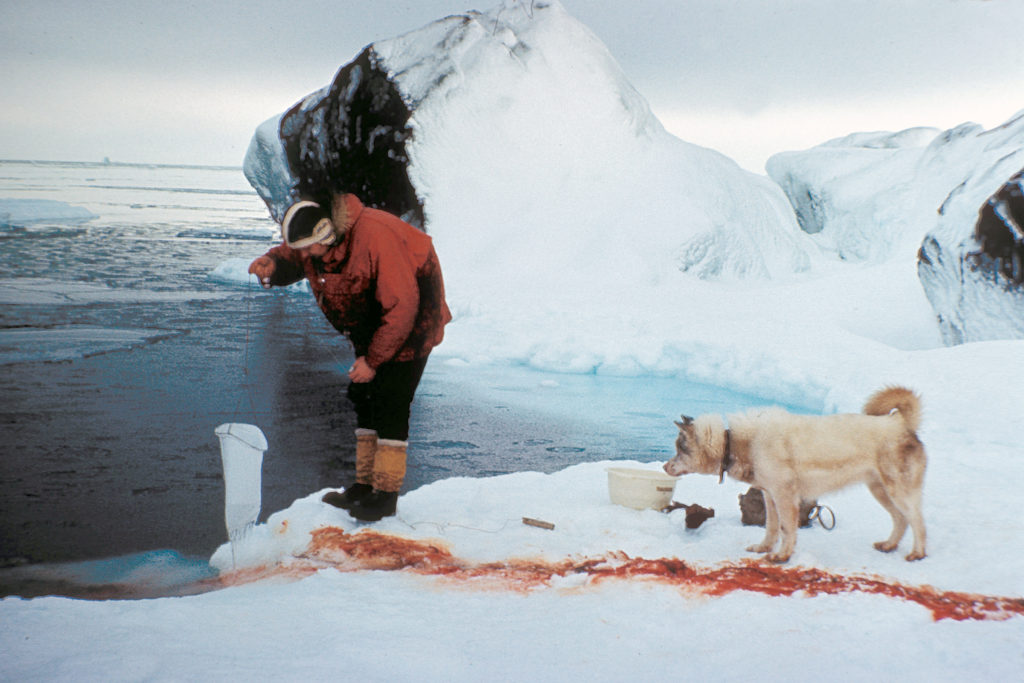
“We celebrated four winter birthday parties. The Saturday night was generally quiet before a Sunday birthday party such as Tom D’s. His cake went down well, as did the liquor. I noted in my diary that the next day was rather slow in getting going. Jim’s Wednesday birthday was another late night/early morning occasion as was George’s Tuesday one. George had a comment about a sergeant who informed his men that the lieutenant would be giving a talk on Keats. The sergeant expected them all to pay attention, as he knew none of them knew what a keat was. Roger’s birthday cake baked by cook Tom had a voluptuous maiden draped across it wearing the well-known polka-dot bikini.”
“During the onset of winter we heard that Neil Marsden and John Tait from Stonington Island base had had their tent blown away in a gale. They sheltered in a crevasse, and Neil got a frostbitten hand. His skin shed like a glove, but back on base navy rum helped the circulation. On the radio we listened to the Cassius Clay (Mohammad Ali) and Sonny Liston fight. From where we were it sounded fixed.
The American Antarctic base McMurdo sent a message to all Antarctic bases that one of their men had not returned from an excursion outside a building. There was no chance he would turn up at our base; it was a reminder that a mistake in the Antarctic was costly.”
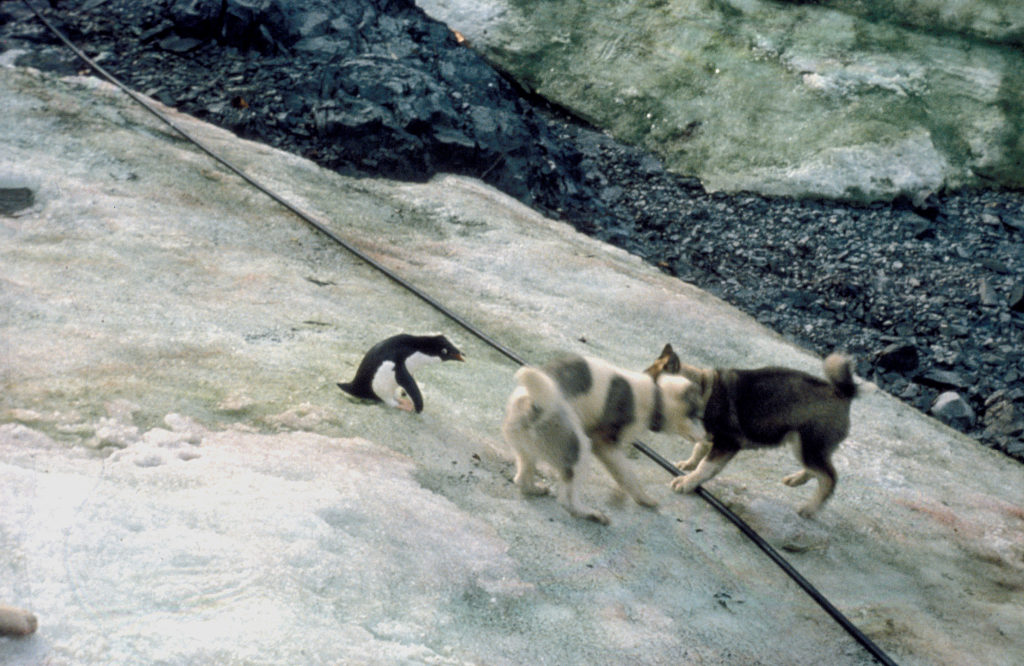
“In June over one hundred Adelie penguins invaded the base as a terrific swell sent brash ice crashing on to the rocks. I did my own geological mapping of these rocks. On the radio we heard that two Americans were recovered from a space flight. Six days on, and for us hard to believe, the Beatles received the Order of the British Empire. There was much discussion on the wisdom of this award.”
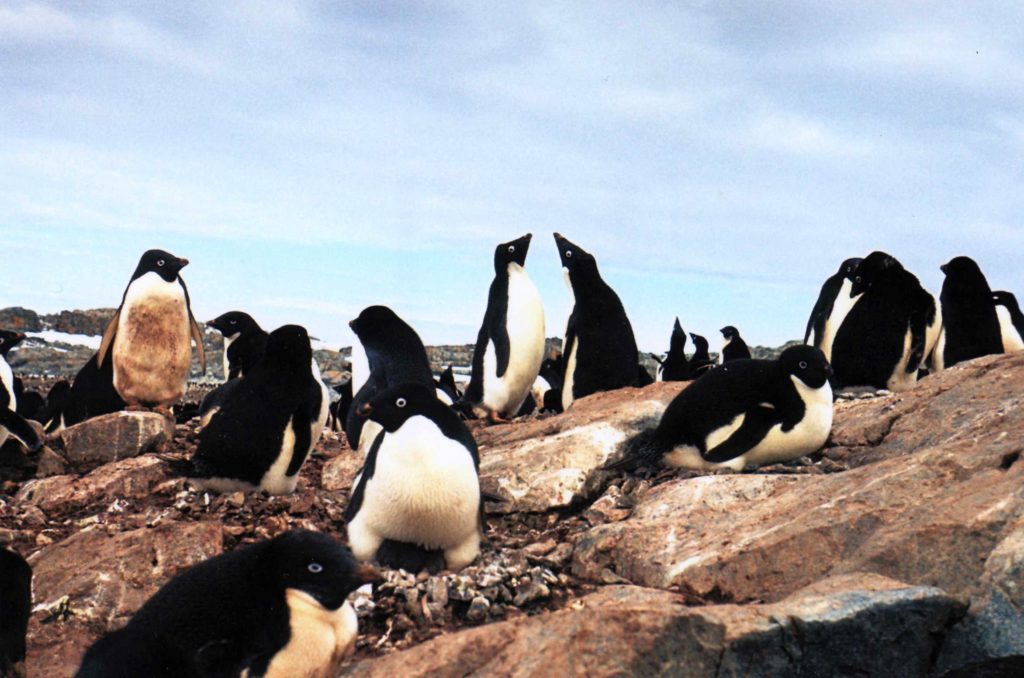
“The increased light and warmth brought courting, and then nesting birds to Avian Island. Antarctic petrels, pure white snowy petrels, and Wilson’s petrels flocked in. More gulls, terns, skuas, and giant petrels arrived. The black-coated shags with their white throats, blue eyes, and orange bills sat on their raised nest mounds. The Adelie penguins headed down the west coast of Adelaide Island, (swimming up to 20 mph), cut across the island’s corner through our base, (generally avoiding the dogs), and, in a steady stream, slid over what sea ice there was to nest among the Avian rocks.
We later collected several hundred-penguin eggs, and stored them in flour for the winter. The eggs were edible in well-beaten omelettes, or a cake. When fried the “whites” stayed clear, and the yellow yolk looked like a large penguin eye staring at you, but they made a change from dried egg powder.”
“For the base a more momentous event at the end of September was the arrival of the aircraft “294” from Deception Island. It was also important for Tony Rider, John Tait, and Jimmy Gardner. With two dog teams these three from Stonington had sledged north to check on the old base at Detaille Island. The base, just east of the north end of Adelaide Island, had been sited on a small island more for the convenience of the ship’s captain than access to the mainland. Gales had blown the sea ice out; the three Fids were now four miles from the mainland surrounded by water. They needed human food, dog food, and coal.” ***
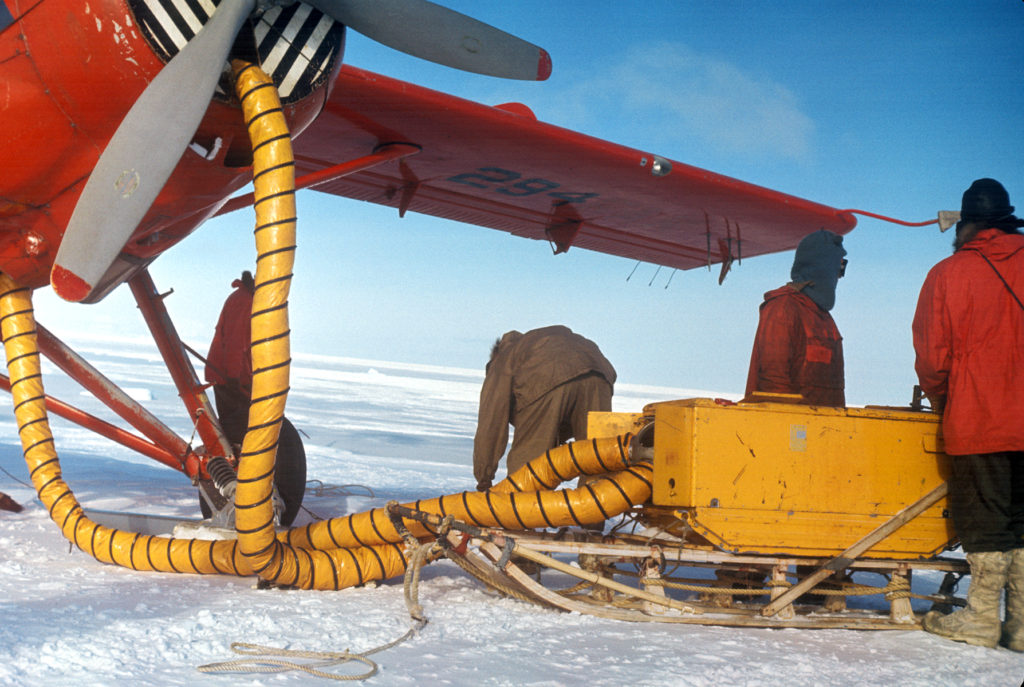
“The main thrust of Adelaide’s spring activities was supporting the plane’s field tasks. “
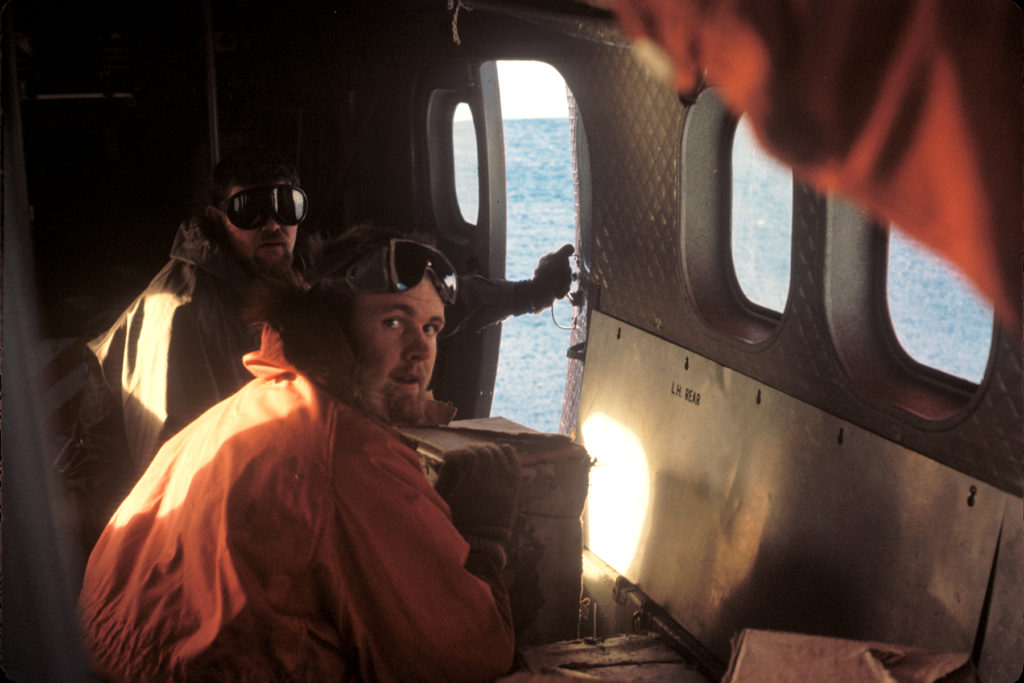
“with the plane’s engine heated up with a Herman-Nelson heater Jules flew the Otter with Mac, Roger and me, the seventy miles to Detaille Island. We headed east, then north up the Laubeuf Fjord, and across to Lallemand Fjord. The island looked rather small, and there was nowhere to land. The three little figures below waved as Roger and Mac pushed supplies out of the side of the plane. The stranded Fids were going to have an even longer winter than the rest of us.”
“After the initial Detaille Island drops, Stonington field teams were given air support. The Otter would carry a whole team and sledge with supplies over a distance of several hundred miles. Only six hundred feet of distance was needed to land if fully loaded, and four hundred feet if unloaded. The weather controlled the plane’s flying. The weather, on the east coast of the Antarctic Peninsula where some teams were, could be completely different from the Marguerite Bay side.”
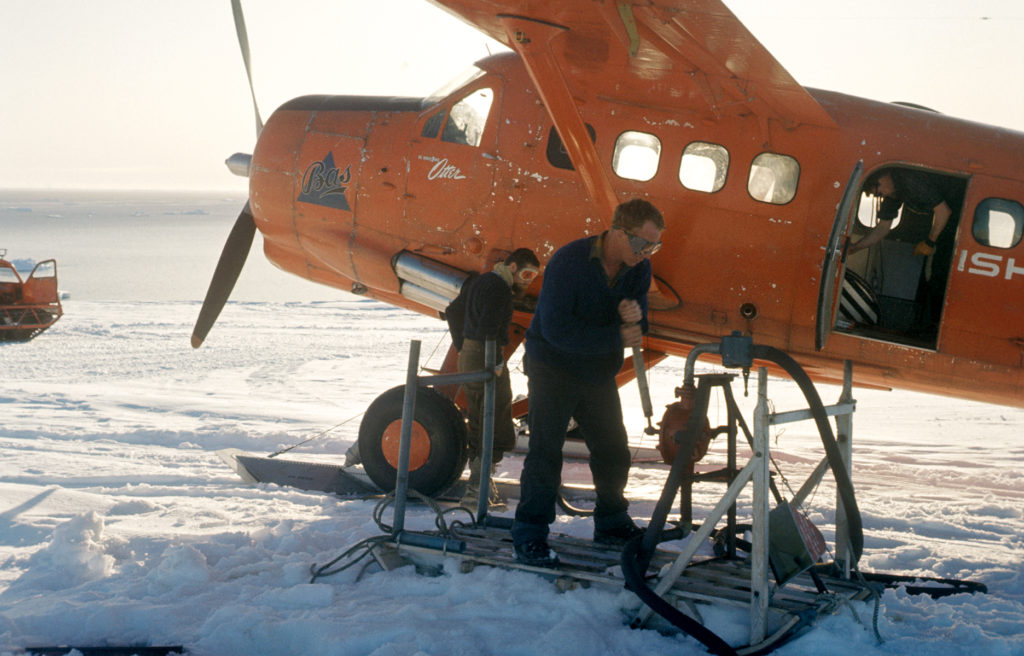
“At Detaille Island John Tait boated Tony Rider, twelve huskies, food, and a sledge to Johnstone’s Point on the mainland. John returned to Detaille through difficult sea ice. The idea was to forge a way up icefalls to an area where the plane could pick the Fids up, or they could sledge back. The movement of sea ice stopped further boat trips; the stranded party was now split in two. A London missive stressed that these Fids were to stay put, and Jules was not to take any risks with the plane though one beer was dropped to a stranded Tony.”
“By the end of December ships were on their way to Marguerite Bay. Field teams and trippers started making their way back to base. At Lincoln Nunatak Edwin played chess by radio with Jimmy Gardner at Detaille Island, but the three marooned Fids were not going to leave their tiny island.”
“Six days later the weather matched my low feelings. My time to leave on the Biscoe had come. I had run all eleven dogs for over eight miles the day before: I didn’t feel like leaving just yet. But base life carried on. There was another large booze up, with the new people and the Biscoe crew including Peter Hay who was being demoted or promoted, depending on your viewpoint, from third officer on the Biscoe to fourth met man at Adelaide Island. He became a Fid by unintentionally stepping into the cold sea between the scow and the jetty. Next Peter and the second officer deliberately swam in the sea off the motorboat placed strategically by an iceberg. And I received one bottle of whisky from Roger for winning the “is she or isn’t she” pregnant Brownie bet.”
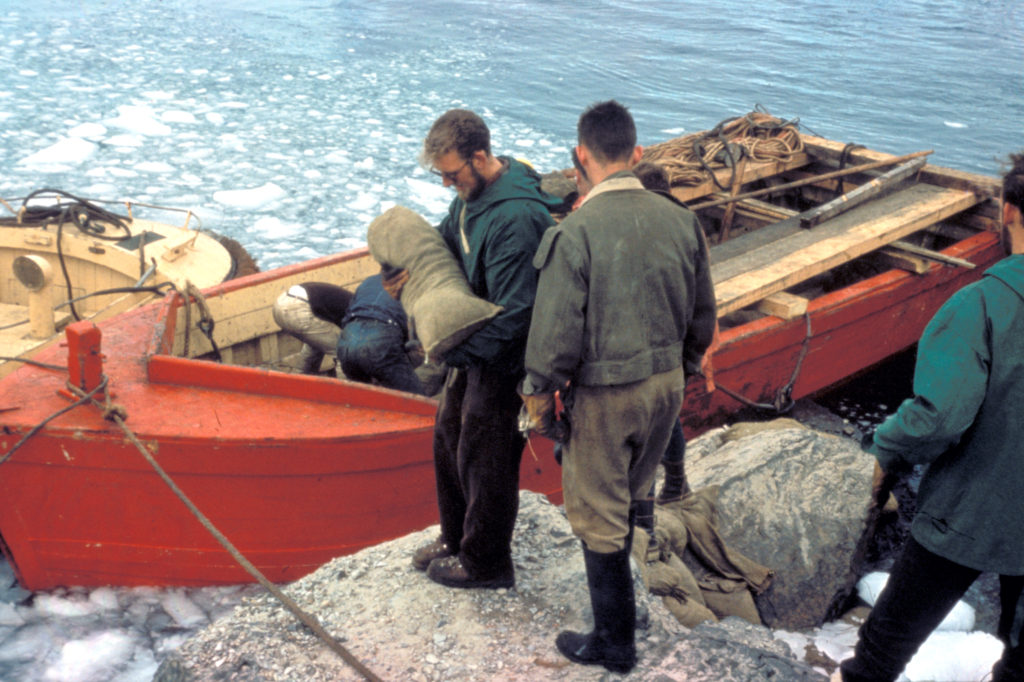
“Unloading with a three-year supply of food continued in case the Marguerite Bay sea ice became difficult again. On board ship that evening, the film The Pumpkin Eaters was only fair. But a big cheer went up when London Zoo penguins were spotted; we were not too sophisticated.”
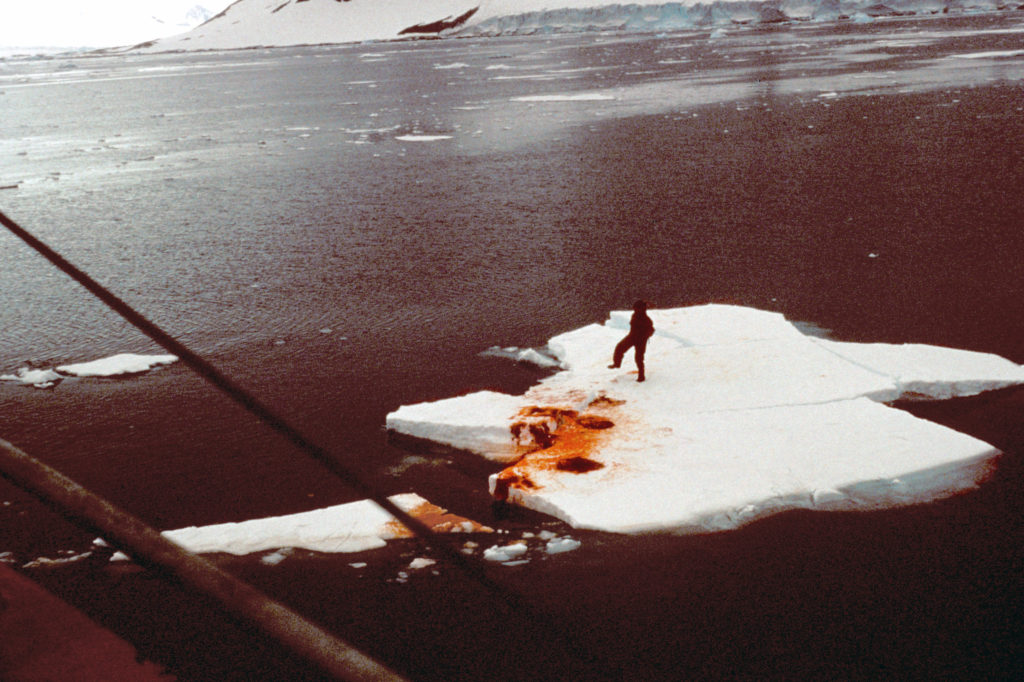
“The large number of Stonington Island huskies needed a lot of seals. So we went sealing among the ice floes of Neny Fjord, southeast of Stonington base. Tony Rider created a photographic moment by standing astride a splitting blood-spattered floe that the Biscoe had just rammed.”
“This ship finally relieved the three Fids who had been stranded on Detaille Island for six months.
Other visitors were two orange USS East Wind navy turbo-helicopters. They photographed rather well outlined against the sky and the off-white snow.”

“The Governor’s presence seemed to unsettle us. I stepped into the sea over my gumboots, and tipped a plate over myself at dinner. Len dropped a Pyrex bowl full of potatoes. However, it was nice to eat chicken eggs and fresh meat for a change. The next day things improved. Sir Cosmo questioned me about the dogs at the span, and easily kept the conversation flowing. The Governor then left on the Shackleton. “
“The final eight weeks of my Antarctic life were a mixture of seasickness, boredom, restlessness, and the odd bit of interest. A couple of birthdays, including mine, led to crowded alcoholic cabin parties; some meteorological observations were missed. The two BAS ships separated for home with violent, colourful flares. I took more anti-seasick pills as we went up and down the Adelaide Island coast in sixty to seventy knot winds. On the radio we listened to the big election win by the Labour Party in Britain; the outside world was starting to encroach.”
“I saw my last iceberg. It was a poignant reminder that for me the Antarctic was finished. Most Fids wouldn’t see the southern ice again, though the memories would never leave us. The silences had contrasted with the sounds of blizzards. The isolation had brought us together, but also showed up our differences. The still white scenery left permanent images. And the huskies that responded to us, and gave more than they received, were remembered.”
*** – Note – the full story of the Detaille Island party’s problem is told on the Stonington page, 1965 – https://margueritebay.org/stonington/
